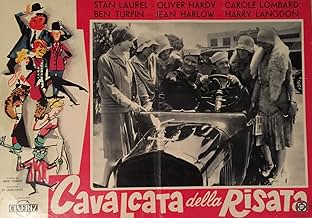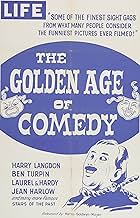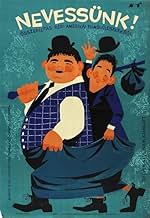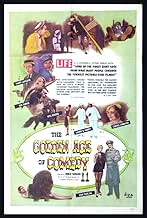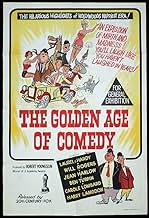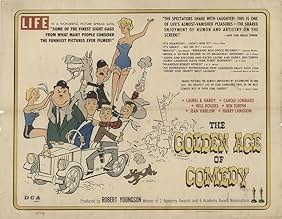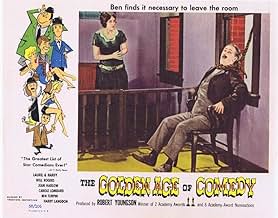Ajouter une intrigue dans votre langueA compilation of scenes featuring some of the best-known comics from the silent era in their best films.A compilation of scenes featuring some of the best-known comics from the silent era in their best films.A compilation of scenes featuring some of the best-known comics from the silent era in their best films.
Stan Laurel
- Stan
- (archive footage)
- (as Laurel)
Oliver Hardy
- Ollie
- (archive footage)
- (as Hardy)
Ben Turpin
- Rodney St. Clair
- (archive footage)
Andy Clyde
- Andy
- (archive footage)
Ward Wilson
- Self - Narrator
- (voice)
Edgar Dearing
- Policeman at Car Fight
- (archive footage)
Madalynne Field
- Fat Girl Track Competitor
- (archive footage)
Avis en vedette
Robert Youngson's first big compilation of silent comedy clips holds an important place in the history of film. Before this film, silent films were viewed as creaky antiques, suitable only for the occasional sneering jeer, like the "Goofy Movie" series and the rare fond memory of old-timers. It was only beginning in 1949, with Walter Kerr's article on the "Four Greats" of silent comedy, that a reappraisal began.
If, as some reviewers complain, there is no Lloyd, Keaton or Chaplin available here, well, their place was already being reestablished or, in Chaplin's case, had never been questioned. If the movie begins with a series of clips from the Sennett studios, it was surely Sennett's reputation which had sunk lowest, until he was recalled only as a purveyor of primitive pie fights in worn-out prints. Here, Youngson offers them in clean copies with admiring voice-overs and good musical accompaniment. If they're not the way the audience was intended to see them -- as complete films -- this surely shows them off to advantage as they had not been seen in thirty years. If nowadays the purist sneers at the film's perceived shortcomings, he should recognize that without Youngson's daring and surprisingly successful offering here, that purist would probably have never heard of those talents; given that almost all that survives of the Laurel & Hardy THE BATTLE OF THE CENTURY exists only because Youngson put most of its second reel here....
If, as some reviewers complain, there is no Lloyd, Keaton or Chaplin available here, well, their place was already being reestablished or, in Chaplin's case, had never been questioned. If the movie begins with a series of clips from the Sennett studios, it was surely Sennett's reputation which had sunk lowest, until he was recalled only as a purveyor of primitive pie fights in worn-out prints. Here, Youngson offers them in clean copies with admiring voice-overs and good musical accompaniment. If they're not the way the audience was intended to see them -- as complete films -- this surely shows them off to advantage as they had not been seen in thirty years. If nowadays the purist sneers at the film's perceived shortcomings, he should recognize that without Youngson's daring and surprisingly successful offering here, that purist would probably have never heard of those talents; given that almost all that survives of the Laurel & Hardy THE BATTLE OF THE CENTURY exists only because Youngson put most of its second reel here....
10Petey-10
In 1957 Robert Youngson directed The Golden Age of Comedy which is a documentary with clips from the silent movies with our favorite comedians.You can see Stan Laurel and Oliver Hardy as jail birds who escape and they have to prove that they are painters.And in one clip Laurel and Hardy are having problems with cars and especially with the ones who are driving them.And who could forget the legendary pie throwing scene.The baby face Harry Langdon, offers lots of funny moments in the train.Billy Bevan and Mack Sennett's Cameo dog are hilarious.There are also clips from actors such as Will Rogers, Carole Lombard, Jean Harlow and the cross eyed Ben Turpin.For true silent comedy lovers it is impossible to get bored with The Golden Age of Comedy.Watch these golden clips from the silent era and have fun!
THE GOLDEN AGE OF COMEDY was producer-director Robert Youngson's first compilation feature film consisting of clips from silent era comedy shorts. The movie was a surprise hit in 1957 and led to six more films of this nature spanning into 1970 as well as 1964's THE BIG PARADE OF COMEDY with clipped MGM feature films. This obviously isn't the best way to see silent comedies but it's very good and was a very rare chance for the general public in the 1950's and 1960's to see silent movie footage, particularly on a theater screen and certainly Youngson's films were an invaluable contribution to the burgeoning popularity of these vintage films which had begun to find their way onto the home movie market via Super 8, 8mm, and 16mm.
A number of the reviewers here have panned or given limited praise to this film because of the conspicuously missing silent era legends like Chaplin, Keaton, and Lloyd however the movie never suggests it is an definitive look at silent comedies just a "memory book" of what the era was like and the type of wild humor audiences enjoyed some thirty earlier. The clips all come from either Hal Roach or Mack Sennett films and are actually limited to 1920's films, nothing from the 1910's that I can tell. Laurel and Hardy enjoy the most footage with an extended abbreviation from TWO TARS (an interesting look at 1920's road rage which we are told is one of the acknowledged classic shorts but actually seems one of the less funny of the segments given it's fairly repetitive and predictable). I think the boys are better served by footage as ingenious prisoners who paint their way to an escape, a short but funny bit about the perils of reading street signs in the dark, or walking city streets with open manholes. There's also footage from the classic DOUBLE WHOOPEE thanks to Jean Harlow's legendary appearance in the short in her shorts.
Harry Langdon called "one of the great four comedians of the screen" (the other three are not mentioned by name but we know who they are) in a segment that is cute but underwhelming. At least it's better than the seldom funny Ben Turpin or Will Rogers' surprisingly not too successful attempts at burlesquing movie heroes from the short UNCENSORED MOVIES. Lovely teen-aged Carole Lombard is shown in footage from RUN GIRL RUN where most of the comic gags are played by pint-sized coach Daphne Pollard or fat girl Madelyne Field. One of my favorite comedians, Charley Chase is seen in an amusing segment with a brat kid and a circus lion.
Surprisingly much of the funniest footage comes from unheralded (and often uncredited here) comics in various early bits as well as a checkers-playing cat and poker-cheating dog. There is an extended quite funny pie fight riot as well as pants-pulling, knee-kicking street war led by Laurel and Hardy as well as such stock silent comedy staples as the horse-driven fire engines, train tunnels, criminals on the loose on a train, houses falling apart like paper, et al. Do try to see these comics in unedited form in their original films but if you get a chance don't miss checking out Youngson's historic films that introduced silent comedy to a whole new audience a half-century ago.
A number of the reviewers here have panned or given limited praise to this film because of the conspicuously missing silent era legends like Chaplin, Keaton, and Lloyd however the movie never suggests it is an definitive look at silent comedies just a "memory book" of what the era was like and the type of wild humor audiences enjoyed some thirty earlier. The clips all come from either Hal Roach or Mack Sennett films and are actually limited to 1920's films, nothing from the 1910's that I can tell. Laurel and Hardy enjoy the most footage with an extended abbreviation from TWO TARS (an interesting look at 1920's road rage which we are told is one of the acknowledged classic shorts but actually seems one of the less funny of the segments given it's fairly repetitive and predictable). I think the boys are better served by footage as ingenious prisoners who paint their way to an escape, a short but funny bit about the perils of reading street signs in the dark, or walking city streets with open manholes. There's also footage from the classic DOUBLE WHOOPEE thanks to Jean Harlow's legendary appearance in the short in her shorts.
Harry Langdon called "one of the great four comedians of the screen" (the other three are not mentioned by name but we know who they are) in a segment that is cute but underwhelming. At least it's better than the seldom funny Ben Turpin or Will Rogers' surprisingly not too successful attempts at burlesquing movie heroes from the short UNCENSORED MOVIES. Lovely teen-aged Carole Lombard is shown in footage from RUN GIRL RUN where most of the comic gags are played by pint-sized coach Daphne Pollard or fat girl Madelyne Field. One of my favorite comedians, Charley Chase is seen in an amusing segment with a brat kid and a circus lion.
Surprisingly much of the funniest footage comes from unheralded (and often uncredited here) comics in various early bits as well as a checkers-playing cat and poker-cheating dog. There is an extended quite funny pie fight riot as well as pants-pulling, knee-kicking street war led by Laurel and Hardy as well as such stock silent comedy staples as the horse-driven fire engines, train tunnels, criminals on the loose on a train, houses falling apart like paper, et al. Do try to see these comics in unedited form in their original films but if you get a chance don't miss checking out Youngson's historic films that introduced silent comedy to a whole new audience a half-century ago.
This film was a lot of fun to watch--with some wonderful clips of Laurel and Hardy, Charlie Chase and others. What a lot of fun stuff! However, there is a BIG, BIG problem with the film. Nowhere in it do you see clips of Chaplin, Keaton or Lloyd--the three biggest film comedians of the 1920s. This is akin to a documentary about the 1960s without mentioning Vietnam or The Beatles! It's obvious that Robert Youngson just didn't have access to these other clips or he simply slapped them together without considering this. In his next film, WHEN COMEDY WAS KING, you DO get to see clips of Chaplin and Keaton--but, unbelievably, there is no Harold Lloyd! Well, if you JUST watch the film for its entertainment value, it's great. If you watch it for a historical overview, it is sadly incomplete and gives a false impression of the era.
From the age of the Pie Fight comes this marvellous compilation by Robert Youngson.Watching it you can judge how much sheer joie - de vivre has been lost with the so - called "sophistication "of movie comedy in the ensuing decades.And where are the geniuses to rival Mr Chaplin and Mr Keaton?Who,today,is as universally loved as Mr Laurel and Mr Hardy whose masterwork "Big Business" is featured here? Feel free to laugh uproariously....."For Ghosts may be listening." "The Golden Age of Comedy" used to be a staple of Christmas Day TV. Sitting there watching it with a mince pie and a glass of port must be the nearest thing to paradise this side of the Elysian Fields.
Le saviez-vous
- GaffesThe narrator cites a clip of Laurel and Hardy as coming from "We Slip Up." Laurel and Hardy never made a movie with that title. The actual movie referenced is We Faw Down (1928).
- Autres versionsThere is an Italian edition of this film on DVD, distributed by DNA Srl: "CAVALCATA DELLA RISATA (1957) + LA BOMBA COMICA (Ça c'est du cinéma, 1951)" (2 Films on a single DVD, with "Ça c'est du cinéma" in double version, with alternative cut titled "I terribili antenati di James Bond"), re-edited with the contribution of film historian Riccardo Cusin. This version is also available for streaming on some platforms.
- ConnexionsEdited from The Dare-Devil (1923)
Meilleurs choix
Connectez-vous pour évaluer et surveiller les recommandations personnalisées
Détails
- Date de sortie
- Pays d’origine
- Langue
- Aussi connu sous le nom de
- The First Kings of Comedy
- Consultez plus de crédits d'entreprise sur IMDbPro
- Durée1 heure 19 minutes
- Couleur
- Mixage
- Rapport de forme
- 1.33 : 1
Contribuer à cette page
Suggérer une modification ou ajouter du contenu manquant

Lacune principale
By what name was The Golden Age of Comedy (1957) officially released in Canada in English?
Répondre
